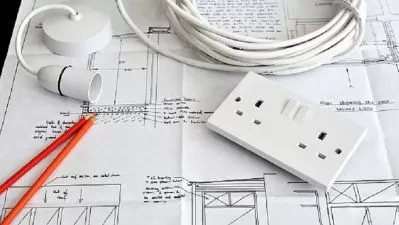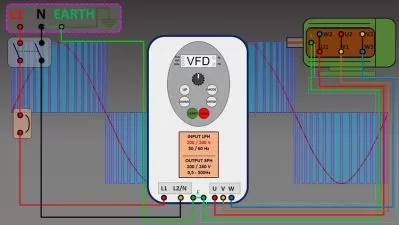Mastering the Art of Circuit Analysis
Dr. Simen Li
5:44:18
Description
Discover the hidden secrets of circuit analysis and unlock your engineering potential.
What You'll Learn?
- Not only learn HOW but also learn WHY in circuit analysis .
- Concepts required to analyze and design circuits, as well as a better understanding of the basics.
- Historical context of fundamental concepts in circuit analysis and their evolution over time.
- Core concept of phasors and how they can be used to analyze and solve a wide range of electrical engineering problems.
- Strong foundation for further study in other areas, e.g. signals and systems, comm. systems, RF transceivers, power systems, etc.
Who is this for?
What You Need to Know?
More details
DescriptionAt the heart of every great engineer lies a strong foundation in the fundamentals.
Do you feel like you're missing something fundamental?
Are you struggling to understand the core concepts of electrical engineering?
Do you feel overwhelmed by the vast amount of knowledge available, and wish you had a key to unlock the door of understanding?
Look no further than "Mastering the Art of Circuit Analysis" - The first course in The Tao of Phasor Series.
This course is not just about analyzing circuits with phasors:
With high-quality content, insightful lessons and engaging storytelling, you'll gain a deep understanding of the fundamental principles that underpin all of electrical engineering.
Our focus is not just on the HOW, but also on the WHY and the evolution of analytical methods in this field.
You'll discover that phasors are not just a mathematical tool, but a KEY to unlock the secrets of electrical engineering.
By the end of this course:
You'll learn how to harness the vast knowledge in this field and apply it to your career.
You'll learn how to master this field and develop the skills that will set you apart from your peers.
You'll have a solid foundation that will impact your entire electrical engineering career.
You'll be well on your way to becoming a confident and successful engineer.
Join us on this journey and discover the joy of understanding the Tao of electrical engineering!
Course Highlights:
Don't overlook this seemingly boring agenda. I am not using a conventional teaching style, but explaining how the circuit analysis approach is built up. This may solve many of the "WHYs" in your mind.
Basic Laws and Methods, Ohm
Kirchhoff Current and Voltage Laws, Kirchhoff
Nodal Voltage and Mesh Current Analysis
History of Electricity
RC and RL Circuits, 1st-order Differential Equation, 1st-order Circuit Response
General Solution for 1st-order Differential Equation, Examples
Reason to Study RLC Circuits
Kelvin, Ruhmkorff Coil
RLC Circuit Analysis, Maxwell, and Hertz
2nd-order Differential Equation, Natural Response
Derivatives, Newton, Leibniz, Lagrange, and Arbogast
Heaviside & Heaviside's Trick
Characteristic Equation and Natural Responses
Undamped, Underdamped, Critically Damped and Overdamped
Discriminant and Damping Ratio
Simple Spring System and Pendulum System
Zero-state Response Examples, Complete Response Example
Revisit 1st-order Case
Sinusoidal Properties, Formula of Power Calculations, Magnitude vs. Amplitude
Sinusoidal Excitation Analysis (Time-domain)
Coordinate Systems and Descartes
Complex Plane and Gauss
Complex Numbers, Complex Plane and Sinusoidal Wave
Complex Excitation Analysis (Time-domain), Phasor Excitation Analysis (Frequency-domain)
Phasor Plane and Its Base Function
Sinusoidal Waves Synthesis
Phase Noise: The Leeson's Model
Phasors Everywhere
Impedance and Admittance, Kirchhoff’s Laws
Mr. Bigs, Steinmetz
Challenges and Silver Lining, The Paper, and Carson
The Beauty of Phasor
Who this course is for:
- Students studying E.E. who want to accelerate their learning, gain a solid foundation and build confidence in circuit analysis. This is for you!
- Engineers who want to develop a strong foundation in E.E. principles, refresh their knowledge and expand skill with informative ideas. This is for you!
- Educators seeking a comprehensive resource to supplement their curriculum and teaching toolkit. This is for you!
- Examination candidates seeking a way to gain the knowledge necessary to succeed. This is for you!
At the heart of every great engineer lies a strong foundation in the fundamentals.
Do you feel like you're missing something fundamental?
Are you struggling to understand the core concepts of electrical engineering?
Do you feel overwhelmed by the vast amount of knowledge available, and wish you had a key to unlock the door of understanding?
Look no further than "Mastering the Art of Circuit Analysis" - The first course in The Tao of Phasor Series.
This course is not just about analyzing circuits with phasors:
With high-quality content, insightful lessons and engaging storytelling, you'll gain a deep understanding of the fundamental principles that underpin all of electrical engineering.
Our focus is not just on the HOW, but also on the WHY and the evolution of analytical methods in this field.
You'll discover that phasors are not just a mathematical tool, but a KEY to unlock the secrets of electrical engineering.
By the end of this course:
You'll learn how to harness the vast knowledge in this field and apply it to your career.
You'll learn how to master this field and develop the skills that will set you apart from your peers.
You'll have a solid foundation that will impact your entire electrical engineering career.
You'll be well on your way to becoming a confident and successful engineer.
Join us on this journey and discover the joy of understanding the Tao of electrical engineering!
Course Highlights:
Don't overlook this seemingly boring agenda. I am not using a conventional teaching style, but explaining how the circuit analysis approach is built up. This may solve many of the "WHYs" in your mind.
Basic Laws and Methods, Ohm
Kirchhoff Current and Voltage Laws, Kirchhoff
Nodal Voltage and Mesh Current Analysis
History of Electricity
RC and RL Circuits, 1st-order Differential Equation, 1st-order Circuit Response
General Solution for 1st-order Differential Equation, Examples
Reason to Study RLC Circuits
Kelvin, Ruhmkorff Coil
RLC Circuit Analysis, Maxwell, and Hertz
2nd-order Differential Equation, Natural Response
Derivatives, Newton, Leibniz, Lagrange, and Arbogast
Heaviside & Heaviside's Trick
Characteristic Equation and Natural Responses
Undamped, Underdamped, Critically Damped and Overdamped
Discriminant and Damping Ratio
Simple Spring System and Pendulum System
Zero-state Response Examples, Complete Response Example
Revisit 1st-order Case
Sinusoidal Properties, Formula of Power Calculations, Magnitude vs. Amplitude
Sinusoidal Excitation Analysis (Time-domain)
Coordinate Systems and Descartes
Complex Plane and Gauss
Complex Numbers, Complex Plane and Sinusoidal Wave
Complex Excitation Analysis (Time-domain), Phasor Excitation Analysis (Frequency-domain)
Phasor Plane and Its Base Function
Sinusoidal Waves Synthesis
Phase Noise: The Leeson's Model
Phasors Everywhere
Impedance and Admittance, Kirchhoff’s Laws
Mr. Bigs, Steinmetz
Challenges and Silver Lining, The Paper, and Carson
The Beauty of Phasor
Who this course is for:
- Students studying E.E. who want to accelerate their learning, gain a solid foundation and build confidence in circuit analysis. This is for you!
- Engineers who want to develop a strong foundation in E.E. principles, refresh their knowledge and expand skill with informative ideas. This is for you!
- Educators seeking a comprehensive resource to supplement their curriculum and teaching toolkit. This is for you!
- Examination candidates seeking a way to gain the knowledge necessary to succeed. This is for you!
User Reviews
Rating
Dr. Simen Li
Instructor's Courses
Udemy
View courses Udemy- language english
- Training sessions 64
- duration 5:44:18
- Release Date 2023/06/16

















